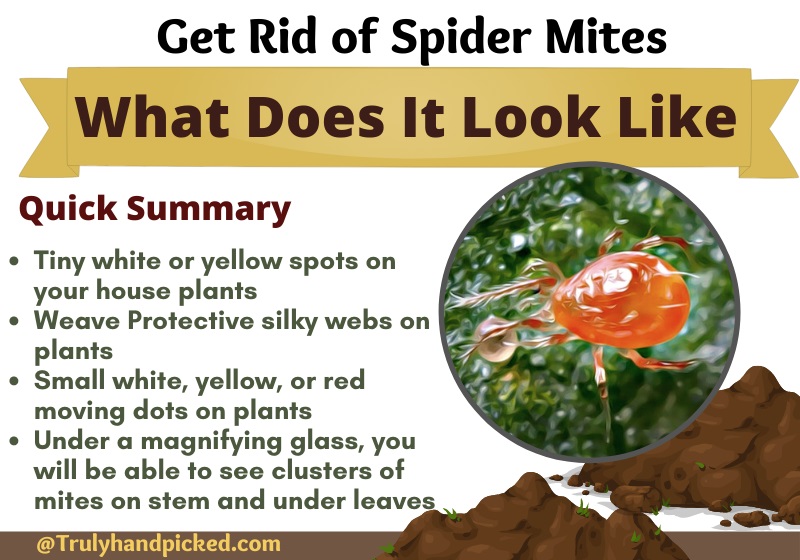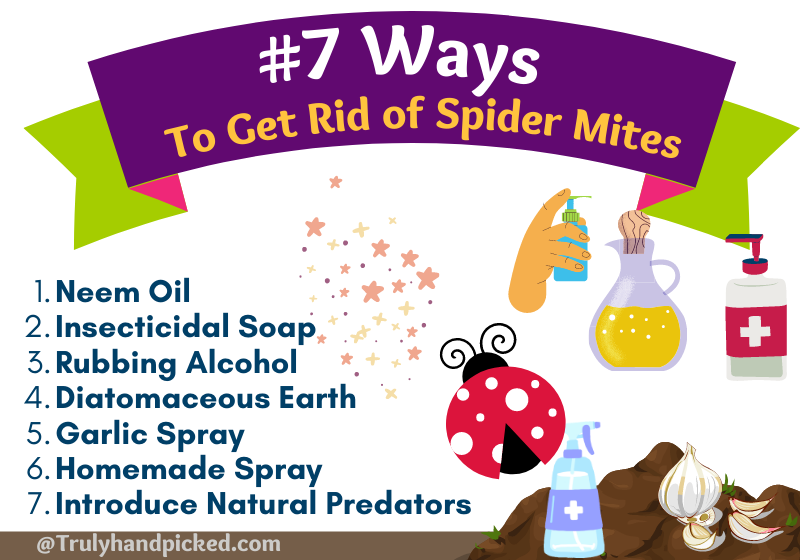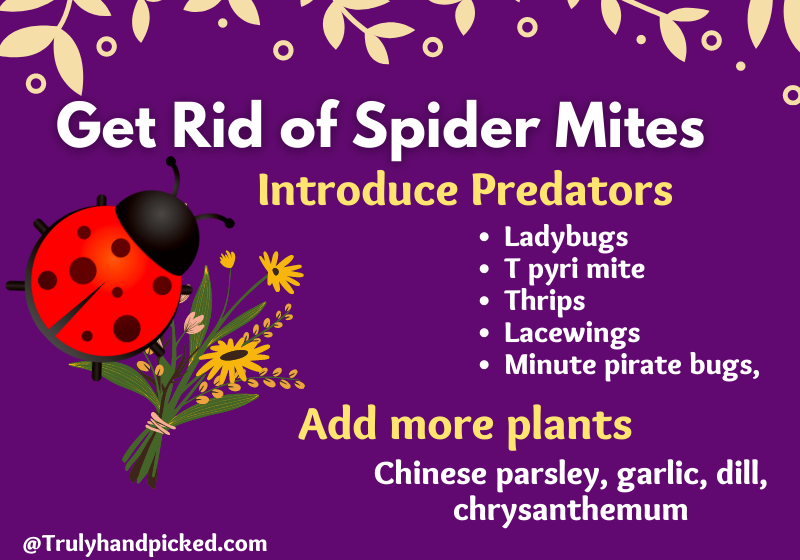There’s nothing more annoying for a gardener than finding destructive pests on their garden plants. Things get more difficult when such insects are hard to see on your plants, like spider mites. Spider mites are one tiniest insect that spreads telltale spider webs on stems as well as leaves and can cause serious damages to your houseplants if you keep them untreated. The good thing is that you can get rid of spider mites entirely with proper remedies, once you identify them on your houseplants.
Spider mites are tiny creatures with eigh legs and needle like mouth part and feed on plant tissues and sap. Infested plants will have web structures and white or yellowish spots on leaves. The plant will look lifeless and even curled up leaves.
To get rid of these sap-sucking mites, quarantine, wash the plant, use neem oil, rubbing alcohol, insecticidal soap.
Most plants with less infected leaves will recover faster, while heavily infested plants will need extra care and methods to get rid of it.
What Do Spider Mites Look Like?
Technically these mites are called Tetranychidae, while commonly known as red spider mites and two-spotted spider mites.
Spider mites are extremely tiny creatures, and it is quite impossible for a gardener to spot them on a plant at their primary stage. They have a smaller cranium that is tinier than a pinhead following a tiny torso and eight legs, which give them a spider-like look. Spider mites can come in different shades from red or yellow to brown or black.
- You will be able to notice tiny white or yellow spots on your house plants.
- As the name suggests, you can witness a silky web woven by the spidermites on your plant stem and leaves.
- They are so tiny you need to use a magnifying glass to see the clear picture of the creature. Though the female spider mites are a little larger than males and will be visible as small moving dots on leaves.
- The web spun and the tiny moving yellow or white dots on your plant leaves confirm the presence of spidermites infestation on your plants.
You can also check for aphids and mealybugs infestation with distinct signs to take measures to get rid of them early before it’s out of hand.
Where Do They Come From?
Spider mites actually can come from environmental conditions and from an infected new plant to your garden. Sometimes, they can appear through soil or any infested plant near your yard. Unfortunately, it is hard to mention, where do they exactly come from! Spider mites can come from anywhere and spread everywhere once they get a new object to infest their clan. Be sure to quarantine any newly brought plant from the nursery or cuttings from your neighbor or friend, before adding it to your garden.
Early Signs and Symptoms: How to know about spider mites infestation?
- The infected plant will have silvery dots or stippling on the leaves at the primary stage
- Then, your plants will start looking dry and unhealthy
- You can find a small web on the underside of leaves
- Your houseplant may look dusty from a distance
- It will appear like you are not giving enough water to your plant
- You will find tiny yellow or whitish spots on the top of the infected leaves
- A silky woven web-like cover will be found around the plant
- And you can find a metallic brown-like appearance on many areas of your plant if it’s heavily infested.
How to Get Rid of Spider Mites:
Some natural remedies are heavily effective on spider mites and can give you a complete cure. The best part is that they work without damaging the health of your favorite houseplants, unlike expensive pesticides. Some of the most effective home remedies of spider mites are-
#Rubbing Alcohol
Use Diluted rubbing alcohol and spray on the underside of leaves and stem. Also, you use the solution to wipe the spider mites web and clusters to dehydrate and let them die. Later use a stream of water to clean off.
1. Neem Oil for Spidermites:
Neem oil is one of the effective pest repellents that can wipe out the infestation of spider mites from your houseplant easily. Azadirachtin from neem oil makes the plant resistant to spider mite attacks and turns into a systematic insecticide.
Process of Usage-
- Combine with 0.25 tsp of raw neem oil extract with 1 quart of warm water and pour in a spray bottle
- Spray the mixture on the infected plant thoroughly, especially around the stem and leaves
- Now wrap your plant with cover afterward and repeat this method in a 7-day interval until you clear the grasp of spider mites from your plant entirely.
2. Homemade Baking Soda Vinegar Spray :
Some homemade sprays are equally good to treat spider mites like readymade insecticides. Here we pick the best one for you, let’s take a look-
ACV-Baking soda Mix:
- To prepare this mixture, take 1/8 cup of raw apple cider vinegar in a spray bottle
- Pour 1 cup of clear water with ½ tbsp of baking soda and 4-5 drops of liquid dish soap
- Close the bottle and shake it up thoroughly until you combine the inside materials finely
- Now sprinkle the mixture on the spider mites along with the entire infected plant daily
- Keep repeating this method for several days and then, rinse your plants with a force of clear water, once you find that spider mites are all dead
- This method goes best with garden plants or landscape plants rather than indoor plants.
3. Diatomaceous Earth:
This is one of the best organic pest repellent options a gardener can have. This is one type of fossil aquatic organism that can kill spider mites completely and act non-toxic to the health of your favorite houseplant. It attacks on the exoskeleton and dehydrates it to make the spider mites vulnerable.
Method
- Bring a (food grade) packet of diatomaceous earth powder and wear safety measurements like gloves before applying
- Now toss a handful of diatomaceous earth powder around the plant as well as over the lawn
- You can even use a dust spreader and sprinkle the powder on your infected plant evenly
- Repeat this process for a couple of days until you can see a clear noticeable result on the spread of spider mites on your plants.
4. Natural Predators to Feed on Spidermites:
Bringing natural predators to your garden area can save you from the damaging grasp of spider mites. You just need to allure those predators near your plant and they will do the rest curing job for you. Some of the typical natural predators of spider mites are-
- Stethorus punctum ladybugs
- T pyri mite
- Thrips
- Lacewings
- Minute pirate bugs, etc.
5. Liquid Dishwash or Insecticidal Soap Spray:
Research proves that dish soap can kill spider mites from your houseplant easily without hampering the growth of that plant anyhow. You just need to pick the right dish soap with less harmful toxins and must know how to apply it accordingly. Organic dish soaps are the best choice for such purposes.
Process of Usage-
- Take 2 tbsp of organic dish soap like pure Castile liquid soap/insecticidal soap in a spray bottle with 1 cup of warm water
- You can alter the water with some oils like vegetable oil, peanut oil, soyabean oil, etc.
- Now shake the bottle after setting the lid and sprinkle the mixture on the infected area of your plant
- Repeat this method for one week consistently to get rid of spider mites fully.
6. Garlic Spray:
Garlic spray is one more natural anti-repellent spray you can use to get rid of spider mites naturally. The deep fragrance of garlic clove keeps the insects away from your houseplants. Moreover, you can find that many expensive pesticides use garlic as one of the basic items in their ingredients.
Process of Usage-
- Take 4-5 big cloves from garlic and finely mince them
- Take the minced garlic cloves in a bowl and mix 1 tbsp of mineral oil into it
- Let it steep this way for 1 whole day and strain the oil in an empty spray bottle after that
- Add 1 teaspoon of dish soap and combine the mixture finely by shaking the bottle several times
- Now, spray this mixture on the infected area of our plant regularly until you get rid of spider mites thoroughly.
How to Prevent Spider Mites:
To control and prevent the infestation of spider mites on your houseplants, try to follow these regulations-
- Quarantine new plants every time you bring one from the nursery, before putting them with the rest of your garden plants
- Check your houseplants closely and very often
- Use insect traps and bugs blocker in your indoor plants
- Attract predators and natural insect hunters to your garden area
- And try to put a variety of plants throughout your garden, which are naturally anti repellent
- Chinese parsley, garlic, dill, chrysanthemum, etc. are some most effective houseplants that help to repel spider mites more innately.
FAQ: Spider mites Infestation on Plants
What Kind of Plants Spider Mites Attack the Most?
Spider mites like plants with juicy stems and starchy leaves. They feed on the tasty cells of varieties of salacious plants like fruit trees, melon trees, strawberry trees, tomato plants, etc.
Do spider mites attack humans?
No spidermites don’t attack humans and while they can cling to your dress and spread and establish a colony in your garden. Spidermites need plants to eat, survive and lay eggs on leaves, and spin webs on plant leaves and stem surfaces, so they can’t survive on humans.
How Long Does It Take to Get Rid of Spider Mites Completely?
Usually, the curing process of spider mites depends on the infestation level and the harshness of the remedy method. Normally, it takes 2-4 weeks to get rid of the nasty grip of spider mites from your garden plant.
Should You Throw Away the Infected Plant?
If the infestation of spider mites is not severe on your house plant, you should not freak out and throw it away. Try to apply the proper remedy and rinse them off from your favorite garden plant as soon as possible.
Does Vinegar Kill Spider Mites?
Vinegar, especially apple cider vinegar is rich in raw acidic content. Thus, this can kill soft-bodied insects like spider mites and cure your houseplant of their grasp. You just need to merge vinegar with the right companion and keep applying them until the spider mites are completely gone from your indoor plants.
Favorite plants for spider mites – plants affected by spider mites
Spider mites can infest a large variety of plants, while most commonly infected plants include tomato, watermelon, peas, beans, strawberries. Spidermites are also attracted to indoor plants for climate and safe play from predators and feast on plant cells for generations.
Spider Mites Life Cycle:
Sider mites follow 5 stages to complete their life cycle. These pests live for about 4-5 weeks and These stages are as follows-
- Eggs: Depending on the temperature a female spider mite reaches adulthood and lays hundreds of eggs under host leaves in her lifetime.
- Larva ( In this stage it only has 6 legs)
- Protonymph nymphal stage
- Deutonymph nymphal stage
- And adulthood




